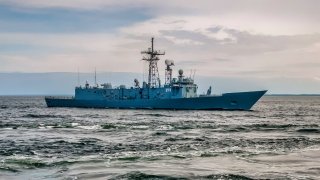The Legacy of the Oliver Hazard Perry-Class Frigates: A Naval Powerhouse
Despite their capabilities, the class was retired as the Navy invested in the less successful Littoral Combat Ships. The Oliver Hazard Perry-class remains a memorable asset in naval history.
Summary: The Oliver Hazard Perry-class guided-missile frigate was a versatile and economical warship introduced in 1971 to replace older WWII-era destroyers.
-Built by Bath Ironworks, these frigates served until 2015, performing anti-submarine warfare, protecting supply groups, and supporting amphibious landings.
-Known for their reliability, they were adopted by several navies worldwide.
-Despite their capabilities, the class was retired as the Navy invested in the less successful Littoral Combat Ships. The Oliver Hazard Perry-class remains a memorable asset in naval history.
Oliver Hazard Perry-Class: The Reliable Warship that Defined U.S. Naval Strength
The Oliver Hazard Perry-class guided-missile frigate was a primary support warship in the US Navy’s surface fleet that performed vital functions, such as anti-submarine warfare to protect possible amphibious landings, as well as to protect supply and replenishment groups, and merchant marine convoys.
The Oliver Hazard Perry-class entered service in 1971 and was meant to replace the World War II-era destroyers that still populated the Navy’s surface fleet with cheaper, lighter, more maneuverable warships.
In all, the Navy procured 51 units of this class and operated them between the 1970s and 2015, when the last model of this class was decommissioned.
The Specs
The Oliver Hazard Perry-class was built by Bath Ironworks in Bath, Maine. Her maximum cruising speed was over 29 knots. The warship was powered by two General Electric LM-2500 gas turbines. Her armaments consisted of Mk 13 Mod 4 missile launcher, capable of firing off 36 RIM-66 Standard/SM-1MR and four Harpoon missiles.
The Oliver Hazard Perry-class was equipped with a Mk75 76mm/62cal (3 inch) rapid firing gun. There were two Mk32 triple-torpedo tubes that could fire 24 Mk46 torpedoes. Two Mk38/25mm machine guns along with M2/.50cal machine guns. These warships were defended by the Mk.15 Phalanx Close-In Weapons System (CIWS).
Not only did the Oliver Hazard Perry become a mainstay of the US Navy’s surface fleet, so too did this class of warship become a key element of the Royal Australian Navy (RAN) the Republic of China’s Navy (Taiwan).
Eventually, the Oliver Hazard Perry-class was sold to other countries, like Spain, Bahrain, Egypt, Poland, Pakistan, and Turkey. The Oliver Perry-class enjoyed a storied service record so much so that in 1997, when the namesake of the class, the USS Oliver Hazard Perry, was set to be decommissioned, there was a push by the United States Coast Guard to absorb the frigates into their fleet.
What Made the Oliver Hazard Perry-class Special
The Oliver Hazard Perry-class was named after the US Navy icon, Commodore Oliver Hazard Perry, the hero of the Battle of Lake Erie during the War of 1812 against the British Empire.
This class of frigate was equipped to carry two, large SH-60 Seahawk LAMPS III helos. A smaller variant of the Oliver Hazard Perry-class could also be made to carry two of the lighter, less capable Seasprite LAMP I helicopter systems (which were subsequently retired from service in 1993).
The airpower element, along with eventual modifications made to future units of this class, such as the Tactical Towed Array System (TACTAS), and the Navy Tactical Display System greatly enhanced the utility of this storied warship.
What’s more, the Oliver Hazard Perry-class prove itself to be proficient in littoral combat settings. That alone should have made the Navy’s boondoggle that was the Littoral Combat Ship (LCS) redundant and unworthy of investment. Sadly, it seems as though the Navy forgot that it did not need to reinvent the wheel as it were.
Rather than simply enhance the already impressive capabilities of the more conventional (and, therefore, reliable) Oliver Perry-class when it came to littoral combat functions, the Navy blew through so much of its budget in the 1990s and 2000s on building the LCS warships that ultimately failed as reliable combatants and had to be removed from service permanently.
Back in the 1990s and 2000s, when the US truly enjoyed global hegemony, having warships capable of littoral combat was important. Today, the Navy needs the capability, but it requires ships that can wage war from a distance, given the proliferation of increasingly complex anti-access/area denial (A2/AD) systems.
Unlike the wasteful LCS, the Oliver Hazard Perry-class might have been useful in this aspect (and since they were older systems, they might have been considered more expendable than newer boats).
An Unforgettable Frigate
Anyway, the Oliver Hazard Perry-class was a wonderful warship that contributed significantly to the safety of United States. It served a vital function in the Navy’s surface fleet. These warships were so popular that multiple countries bought them—and some still utilize them today.
While there are no Oliver Hazard Perry-class guided-missile frigates in the US Navy today, there was an attempt by elements of the US Coast Guard to acquire some of the retired Oliver Hazard Perry-class frigates for their fleet in the late 1990s.
Like Commodore Oliver Perry himself, the class of warship will be forever remembered as a truly great boat. And, if the follow-on warships to the Oliver Hazard Perry-class turn out as badly as either the LCS or Zumwalt-class destroyer did, many will pine for the days when the Oliver Perrys chopped the waves of the Deep Blue Sea.
About the Author
Brandon J. Weichert, a National Interest national security analyst, is a former Congressional staffer and geopolitical analyst who is a contributor at The Washington Times, the Asia Times, and The-Pipeline. He is the author of Winning Space: How America Remains a Superpower, Biohacked: China’s Race to Control Life, and The Shadow War: Iran’s Quest for Supremacy. His next book, A Disaster of Our Own Making: How the West Lost Ukraine, is due October 22 from Encounter Books. Weichert can be followed via Twitter @WeTheBrandon.


